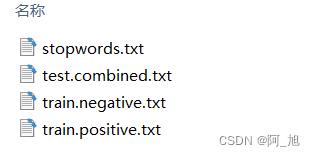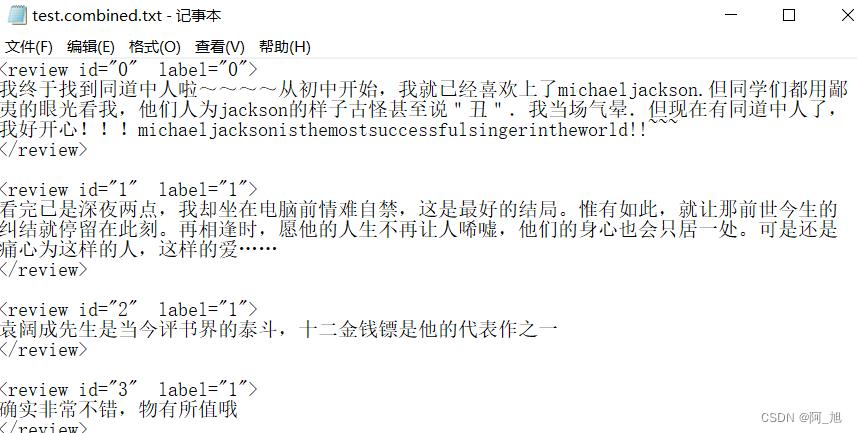阿旭机器学习实战33中文文本分类之情感分析--朴素贝叶斯KNN逻辑回归
Posted 阿_旭
tags:
篇首语:本文由小常识网(cha138.com)小编为大家整理,主要介绍了阿旭机器学习实战33中文文本分类之情感分析--朴素贝叶斯KNN逻辑回归相关的知识,希望对你有一定的参考价值。
【阿旭机器学习实战】系列文章主要介绍机器学习的各种算法模型及其实战案例,欢迎点赞,关注共同学习交流。
目录
1.查看原始数据结构
关注GZH:阿旭算法与机器学习,回复:“ML33”即可获取本文数据集、源码与项目文档
数据集共有4个文件:
stopwords.txt为停用词文件;
train.negative.txt为训练用负面数据文件;
train.positive.txt为训练用正面数据文件;
test.combined.txxt为测试用数据文件。

文件内容如下:


2.导入数据并进行数据处理
from matplotlib import pyplot as plt
import jieba # 分词
import re # 正则
from sklearn.feature_extraction.text import TfidfVectorizer
import numpy as np
2.1 提取数据与标签
def read_data(path, is_pos=None):
"""
给定文件的路径,读取文件
path: path to the data
is_pos: 是否数据是postive samples.
return: (list of review texts, list of labels)
"""
reviews, labels = [], []
with open(path, 'r',encoding='utf-8') as file:
review_start = False
review_text = []
for line in file:
line = line.strip()
if not line: continue
if not review_start and line.startswith("<review"):
review_start = True
if "label" in line:
labels.append(int(line.split('"')[-2]))
continue
if review_start and line == "</review>":
review_start = False
reviews.append(" ".join(review_text))
review_text = []
continue
if review_start:
review_text.append(line)
if is_pos:
labels = [1]*len(reviews)
elif not is_pos is None:
labels = [0]*len(reviews)
return reviews, labels
def process_file():
"""
读取训练数据和测试数据,并对它们做一些预处理
"""
train_pos_file = "data_sentiment/train.positive.txt"
train_neg_file = "data_sentiment/train.negative.txt"
test_comb_file = "data_sentiment/test.combined.txt"
# 读取文件部分,把具体的内容写入到变量里面
train_pos_cmts, train_pos_lbs = read_data(train_pos_file, True)
train_neg_cmts, train_neg_lbs = read_data(train_neg_file, False)
train_comments = train_pos_cmts + train_neg_cmts
train_labels = train_pos_lbs + train_neg_lbs
test_comments, test_labels = read_data(test_comb_file)
return train_comments, train_labels, test_comments, test_labels
train_comments, train_labels, test_comments, test_labels = process_file()
train_comments[:5]
['发短信特别不方便!背后的屏幕很大用起来不舒服,是手触屏的!切换屏幕很麻烦!',
'手感超好,而且黑色相比白色在转得时候不容易眼花,找童年的记忆啦。',
'!!!!!',
'先付款的 有信用',
'价格 质量 售后 都很满意']
# 训练数据和测试数据大小
print (len(train_comments), len(test_comments))
print (train_comments[1], train_labels[1])
8064 2500
手感超好,而且黑色相比白色在转得时候不容易眼花,找童年的记忆啦。 1
2.2 过滤停用词
def load_stopwords(path):
"""
从外部文件中导入停用词
"""
stopwords = set()
with open(path, 'r',encoding='utf-8') as in_file:
for line in in_file:
stopwords.add(line.strip())
return stopwords
def clean_non_chinese_symbols(text):
"""
处理非中文字符
"""
text = re.sub('[!!]+', "!", text)
text = re.sub('[??]+', "?", text)
text = re.sub("[a-zA-Z#$%&\\'()*+,-./:;:<=>@,。★、…【】《》“”‘’[\\\\]^_`|~]+", " UNK ", text)
return re.sub("\\s+", " ", text)
def clean_numbers(text):
"""
处理数字符号 128 190 NUM
"""
return re.sub("\\d+", ' NUM ', text)
def preprocess_text(text, stopwords):
"""
文本的预处理过程
"""
text = clean_non_chinese_symbols(text)
text = clean_numbers(text)
text = " ".join([term for term in jieba.cut(text) if term and not term in stopwords])
return text
path_stopwords = "./data_sentiment/stopwords.txt"
stopwords = load_stopwords(path_stopwords)
# 对于train_comments, test_comments进行字符串的处理,几个考虑的点:
# 1. 停用词过滤
# 2. 去掉特殊符号
# 3. 去掉数字(比如价格..)
# 4. ...
# 需要注意的点是,由于评论数据本身很短,如果去掉的太多,很可能字符串长度变成0
# 预处理部部分,可以自行选择合适的方案,只要注释就可以。
train_comments_new = [preprocess_text(comment, stopwords) for comment in train_comments]
test_comments_new = [preprocess_text(comment, stopwords) for comment in test_comments]
print (train_comments_new[0], test_comments_new[0])
发短信 特别 不 方便 ! 背后 屏幕 很大 起来 不 舒服 UNK 手触 屏 ! 切换 屏幕 很 麻烦 ! 终于 找到 同道中人 初中 UNK 已经 喜欢 上 UNK 同学 都 鄙夷 眼光 看 UNK 人为 UNK 样子 古怪 说 " 丑 " 当场 气晕 现在 同道中人 UNK 好开心 ! UNK ! UNK
2.3 TfidfVectorizer将文本向量化
# 利用tf-idf从文本中提取特征,写到数组里面.
# 参考:https://scikit-learn.org/stable/modules/generated/sklearn.feature_extraction.text.TfidfVectorizer.html
tfidf = TfidfVectorizer()
X_train = tfidf.fit_transform(train_comments_new) # 训练数据的特征
y_train = train_labels # 训练数据的label
X_test = tfidf.transform(test_comments_new) # 测试数据的特征
y_test = test_labels# 测试数据的label
print (np.shape(X_train), np.shape(X_test), np.shape(y_train), np.shape(y_test))
(8064, 23101) (2500, 23101) (8064,) (2500,)
3.利用不同模型进行训练与评估
3.1 朴素贝叶斯模型
from sklearn.naive_bayes import MultinomialNB
from sklearn.metrics import accuracy_score
clf = MultinomialNB()
# 利用朴素贝叶斯做训练
clf.fit(X_train, y_train)
y_pred = clf.predict(X_test)
print("accuracy on test data: ", accuracy_score(y_test, y_pred))
accuracy on test data: 0.6368
3.2 k近邻模型
from sklearn.neighbors import KNeighborsClassifier
clf = KNeighborsClassifier(n_neighbors=1)
clf.fit(X_train, y_train)
y_pred = clf.predict(X_test)
print("accuracy on test data: ", accuracy_score(y_test, y_pred))
accuracy on test data: 0.524
3.3 逻辑回归模型
from sklearn.linear_model import LogisticRegression
clf = LogisticRegression(solver='liblinear')
clf.fit(X_train, y_train)
y_pred = clf.predict(X_test)
print("accuracy on test data: ", accuracy_score(y_test, y_pred))
accuracy on test data: 0.7136
如果文章对你有帮助,感谢点赞+关注!
关注下方GZH:阿旭算法与机器学习,回复:“ML33”即可获取本文数据集、源码与项目文档,欢迎共同学习交流
以上是关于阿旭机器学习实战33中文文本分类之情感分析--朴素贝叶斯KNN逻辑回归的主要内容,如果未能解决你的问题,请参考以下文章